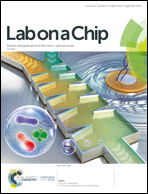Surface acoustic waves enable rotational manipulation of Caenorhabditis elegans†
Abstract
Controllable, precise, and stable rotational manipulation of model organisms is valuable in many biomedical, bioengineering, and biophysics applications. We present an acoustofluidic chip capable of rotating Caenorhabditis elegans (C. elegans) in both static and continuous flow in a controllable manner. Rotational manipulation was achieved by exposing C. elegans to a surface acoustic wave (SAW) field that generated a vortex distribution inside a microchannel. By selectively activating interdigital transducers, we achieved bidirectional rotation of C. elegans, namely counterclockwise and clockwise, with on-demand switching of rotation direction in a single chip. In addition to continuous rotation, we also rotated C. elegans in a step-wise fashion with a step angle as small as 4° by pulsing the signal duration of SAW from a continuous signal to a pulsed signal down to 1.5 ms. Using this device, we have clearly imaged the dopaminergic neurons of C. elegans with pdat-1:GFP expression, as well as the vulval muscles and muscle fibers of the worm with myo-3::GFP fusion protein expression in different orientations and three dimensions. These achievements are difficult to realize through conventional (i.e., non-confocal) microscopy. The SAW manipulations did not detectably affect the health of the model organisms. With its precision, controllability, and simplicity in fabrication and operation, our acoustofluidic devices will be well-suited for model organism studies.



 Please wait while we load your content...
Please wait while we load your content...
